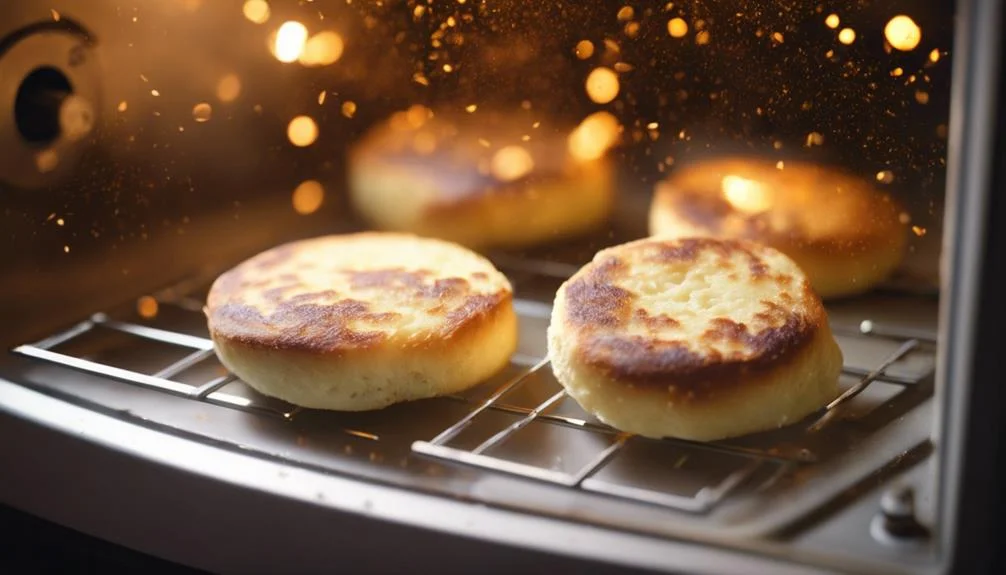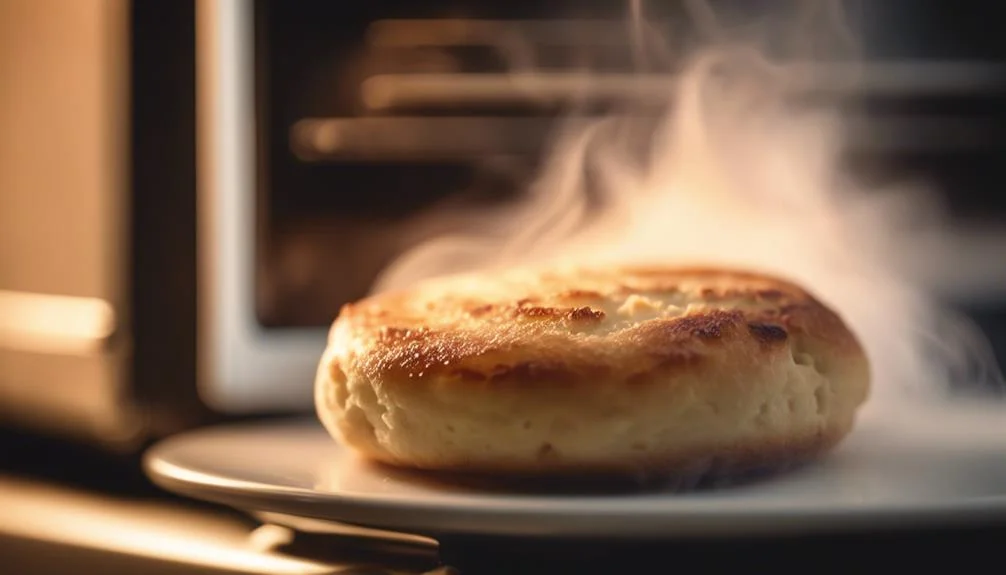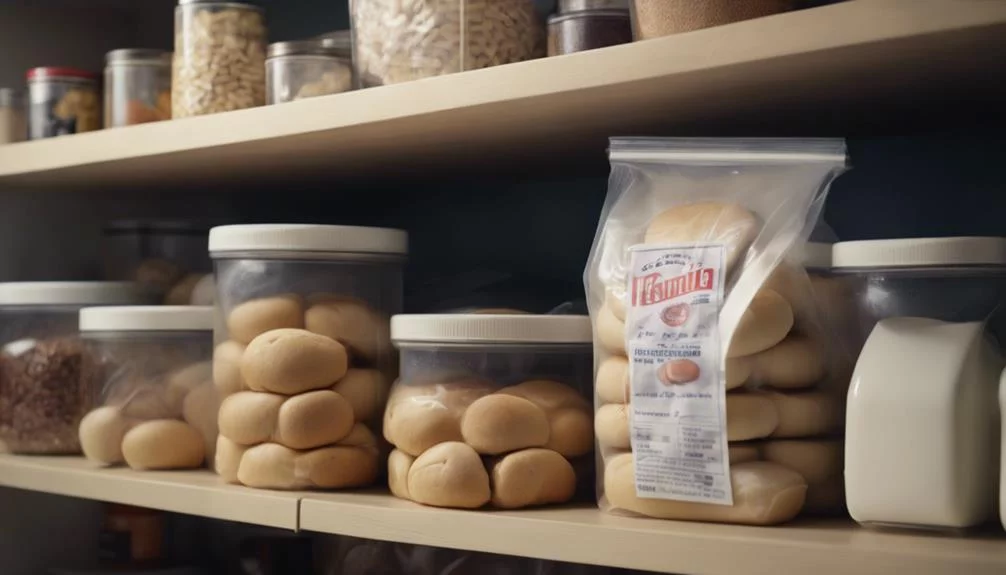Can You Microwave English Muffins
Yes, English muffins can be microwaved. However, the outcome may not always be as desired. Microwaving can result in a softer texture and less crispy exterior compared to toasting in an oven or a toaster.
To achieve the best results, it is recommended to lightly toast the English muffin in a toaster or oven to maintain its traditional texture and flavor. Microwaving can be a convenient option when time is limited, but for optimal taste and texture, toasting is still the preferred method.
Key Takeaways
- Microwaving English muffins is quick and suitable for low-carb diets, but sacrifices traditional crunch.
- Microwave instructions involve placing muffin halves in a dish with water and microwaving for 90 seconds.
- Microwaved muffins are soft and moist, lacking the crispy texture and flavor of traditional toasting.
- Enhance microwaved muffins by adding water for moisture, using short intervals, and toasting in a skillet for crunchiness.
Pros and Cons of Microwaving English Muffins
Microwaving English muffins offers a convenient way to quickly warm them, although it may sacrifice the traditional crunch for a softer texture. This method is easy, especially for those looking for a low-carb breakfast or snack option. In under 2 minutes, the microwave can transform a cold English muffin into a warm treat, suitable for a speedy meal.
While the crunch of a toasted English muffin may be missed, the softness achieved through microwaving can be appealing to those seeking a different texture. To prevent dryness, adding a few drops of water before microwaving can help retain moisture. For a crisper finish, consider toasting the microwaved English muffin in a skillet or toaster post-heating.
Step-by-Step Microwave Instructions
Considering the convenience and speed microwaving English muffins offers, mastering the step-by-step instructions can ensure a satisfying outcome.
- Place the English muffin halves in a microwave-safe dish.
- Add a few drops of water to the dish to maintain moisture during microwaving.
- Microwave the English muffin for 90 seconds, ensuring it pulls away from the sides of the dish to indicate doneness.
These simple steps create a quick and convenient breakfast option, although the muffin may not have the crispy texture achieved through traditional toasting methods.
Achieving Perfect Texture and Flavor

To enhance the overall sensory experience of microwaved English muffins, focusing on achieving an ideal balance of texture and flavor is essential. When microwaving English muffins, it's common to encounter a soft and moist texture, but this often lacks the crispy exterior that toasting provides. To combat dryness, consider adding a few drops of water to the muffin before microwaving to help maintain moisture. Heating the muffins in short intervals, such as starting with 15 seconds, can prevent overcooking and preserve a desirable texture. While microwaving is convenient, toasting in an oven or toaster yields a crunchier, more flavorful outcome. For a truly authentic experience, lightly brown the microwaved muffin in a nonstick skillet for enhanced taste and texture.
| Aspect | Description | Tip |
|---|---|---|
| Texture | Microwaved muffins tend to be soft and moist, lacking the crispy exterior of toasted muffins. | Add a few drops of water before microwaving to maintain moisture. |
| Moisture | Maintaining moisture can be a challenge when microwaving; consider using short intervals to prevent dryness. | Heating in short intervals, starting with 15 seconds, can help. |
| Flavor | While convenient, microwaving may not provide the same flavorful outcome as toasting in an oven or toaster. | For enhanced taste and texture, consider lightly browning in a skillet after microwaving. |
Comparing Microwave Vs. Oven
When it comes to preparing English muffins, the choice between using a microwave or an oven can significantly impact the final texture and flavor of the beloved breakfast staple.
- Microwaving English muffins is a faster method, taking under 2 minutes, while baking in the oven takes 10-12 minutes at 350F/180C.
- Microwave cooking is convenient for single servings, while oven baking can be suitable for larger batches.
- Microwaving may result in a softer texture, while oven baking can provide a crisper exterior.
Both methods yield similar results in terms of taste and texture, making them versatile options for cooking English muffins. Microwaving is ideal for quick breakfast solutions, while oven baking may be preferred for a more traditional approach to toasting English muffins.
Tips for Microwaving English Muffins

When microwaving English muffins, it is important to follow quick tips to achieve optimal results.
Ensuring even heating and preventing sogginess are key considerations when using this method.
Quick Microwaving Tips
For optimal results when microwaving English muffins, consider adding a few drops of water before heating. This simple step can help maintain the muffins' texture and prevent dryness.
To ensure your English muffins are heated evenly and avoid sogginess, follow these quick microwaving tips:
- Heat in short intervals: Begin with 15-second bursts to prevent overheating.
- Avoid dryness: Be cautious not to microwave the English muffins for too long to retain moisture.
- Speedy alternative: While microwaving won't provide a crunchy texture like toasting, it offers a quick breakfast option.
Evenly Heating Methods
To ensure consistent heating and optimal texture when microwaving English muffins, it is recommended to utilize short intervals, starting with 15-second bursts. This method helps prevent overheating and ensures that the muffins are evenly heated throughout.
By using short bursts, you can monitor the warming process closely, making adjustments as needed to avoid drying out the muffins. Adding a few drops of water before microwaving can also help maintain moisture and prevent the muffins from becoming dry.
For a crunchier texture, consider toasting the muffins in a nonstick skillet after microwaving. While microwaving may not provide a crispy texture on its own, toasting them afterward can enhance the overall flavor and consistency of the English muffins.
Avoiding Sogginess Issues
Efficiently achieving the desired texture when microwaving English muffins entails careful attention to short intervals and moisture retention methods.
When it comes to avoiding sogginess while microwaving English muffins, consider the following tips:
- Microwave in short intervals, starting with 15 seconds, to prevent overcooking.
- Maintain moisture by adding a few drops of water to the muffin before microwaving for a fluffy result.
- Avoid overheating the muffin to prevent a dry and tough texture.
Proper Storage Techniques

Properly storing English muffins in an airtight container is essential for maintaining their freshness. By following proper storage techniques, you can extend the shelf life of English muffins and prevent food waste. Here is a table summarizing the best storage methods for English muffins:
| Storage Method | Location |
|---|---|
| Room Temperature | Pantry or bread box |
| Refrigerator | Crisper drawer |
| Freezer | Freezer-safe container |
Commonly Asked Questions
When considering the handling of English muffins, it is important to address some commonly asked questions to ensure a satisfactory culinary experience.
- Can you microwave English muffins for a quick breakfast option?
- How long does it typically take to microwave English muffins?
- What is the best way to prevent dryness when microwaving an English muffin?
Frequently Asked Questions
Are English Muffins Safe to Microwave if They Contain Fillings Like Cheese or Jam?
When considering microwave safety for English muffins with fillings like cheese or jam, the potential benefits include cheese melting to a gooey texture and jam becoming spreadable. This method offers a convenient toaster alternative, but caution with hot fillings is advised.
Can I Use a Toaster Oven Instead of a Microwave to Heat up My English Muffin?
Using a toaster oven as an alternative to a microwave for heating English muffins offers benefits such as crispy texture, flavor enhancement, and customizable browning. It provides a more satisfying breakfast experience by offering superior heating options.
How Long Can I Store Microwaved English Muffins Before They Go Bad?
Proper storage tips enhance the shelf life of microwaved English muffins, ensuring freshness maintenance. Store at room temperature for up to 2 days, or refrigerate for a week. For extended preservation, freeze for 3 months and thaw before reheating.
Will Microwaving English Muffins Make Them Soggy or Dry Them Out?
When microwaving English muffins, maintaining texture preference is crucial. Overheating can lead to dryness while insufficient moisture may cause sogginess. Heat in short intervals, 15 seconds at a time, and consider adding a few drops of water to preserve moisture without sacrificing crispiness.
Can I Use a Microwave to Defrost Frozen English Muffins Before Toasting Them?
When defrosting frozen English muffins, the microwave offers a convenient and speedy option compared to stovetop methods. Toppings like avocado and poached eggs elevate English muffins. Whip up quick breakfast recipes like breakfast sandwiches and French toast with English muffins. Proper storage ensures freshness.
Conclusion
In conclusion, microwaving English muffins is a quick and convenient option, but may not provide the same texture as toasting. By following proper instructions and tips, you can achieve a warm and delicious muffin.
Have you ever wondered if microwaving English muffins could be a game-changer in your breakfast routine? Give it a try and see how it compares to traditional toasting methods.






